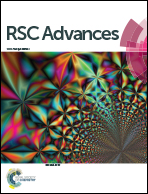Ultrathin mesoporous NiCo2O4 nanosheets as an efficient and reusable catalyst for benzylic oxidation†
Abstract
Ultrathin mesoporous NiCo2O4 nanosheets as a high efficient and reusable catalyst for benzylic oxidation have been prepared. The nanosheets are less than 5 nm in thickness, the pore distribution is in the range of 2–5 nm and the specific surface area of the nanosheets is about 81.0 m2 g−1. The ultrathin and mesoporous features with high specific surface area not only provide large amount of binary active sites of Co and Ni, but also improve the contacting ability between the substrate and these active sites, therefore accelerating the rate of reaction and providing high catalytic efficiency for benzylic oxidation. The NiCo2O4 nanosheets are efficient heterogeneous catalyst in the oxidation of 4,4′-difluorodiphenylmethane into 4,4′-difluorobenzophenone with a yield of 99%. Furthermore, the NiCo2O4 nanosheets catalyst exhibits general applicability, convenient separability and good stability in the benzylic oxidation.


 Please wait while we load your content...
Please wait while we load your content...